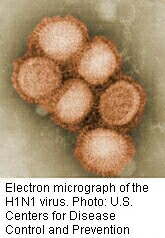
THURSDAY, Jan. 20 (HealthDay News) — This winter, influenza seems to be behaving very differently depending on what side of the Atlantic you’re on.
As of last week, for example, H1N1 (“swine”) flu still predominated in Britain, where 112 people have died, hospitals are filling up with very ill flu patients, and some doctors report running out of vaccine, according to the BBC. Experts are concerned that the virus — known as 2009 H1N1 — could create a similar situation in mainland Europe.
However, in the United States, clinicians are only now starting to see cases of the flu — mostly of the traditional, H3N2 variety — and the atmosphere is much more calm. Vaccine is plentiful and much of it is going unused.
Still, with modern air travel allowing viruses to spread easily around the globe, could the British flu experience travel to America?
That question remains unanswered. According to experts, it’s still relatively early in the flu season and anything could happen.
In Rochester, N.Y., “we’re getting a mix of a little bit of H1N1 but not much. We’re seeing more of H3N2 and some influenza B, so all three players are in the pot,” said Dr. Edward Walsh, an infectious diseases expert and professor of medicine at the University of Rochester Medical Center. “As to which one is going to be dominant, we’re waiting and seeing. I don’t think we can predict that yet.”
Walsh’s reports mirror those of the U.S. Center for Disease Control and Prevention, which says — for the week ending Jan. 8, 2011 — about 8 percent of samples tested were 2009 H1N1 and 31.5 percent the H3N2 variety.
Still, H3N2’s dominance “could change very quickly,” Walsh said.
One theory as to why H1N1 hasn’t made a strong showing in the United States this year is that many Americans gained immunity last season.
“So much of the U.S. population was vaccinated against H1N1 last year and so much immunity developed as the thing spread like wildfire, that’s the reason the predominate strain is H3N2 — it’s all about immunity,” said Dr. Marc Siegel, an associate professor of medicine at New York University in New York City.
But a comeback for the strain — which is typically more serious for younger patients — isn’t out of the question.
H1N1 “appeared at a distinctly odd time in its initial debut in April/May of 2009 [flu season usually ends in March or even a little earlier] so it’s obviously got an unpredictable course as to when it’s going to actually attack a population,” noted Dr. Len Horovitz, a pulmonary specialist at Lenox Hill Hospital in New York City.
“What will happen in any individual country or area, we just don’t know. It’s impossible to estimate,” added Dr. John Carpenter, professor of internal medicine at Texas A&M Health Science Center College of Medicine and division director of infectious diseases at Scott & White in Temple. “We just don’t know if it will come over here. If somebody hops on a plane with it and comes over here…”
But, he added, “if it jumps to Europe, there’s a better chance it will jump here.”
And experts aren’t ruling out the possibility that there could be regional variations in the United States, with different strains leading in different areas.
“You don’t always get the exact same thing in every country or even within every region,” Walsh said.
In the meantime, people should not underestimate the potentially deadly nature of H3N2, which tends to hit the elderly the hardest. Siegel expects to see more elderly patients than last year — and more deaths. H3N2 tends to cause more pneumonia and other complications than other forms of flu, he said.
“Last year, there were 10,000 deaths compared to the normal 34,000 [from flu],” he said. If H3N2 continues to predominate, “the age distribution of deaths this year will be back to the elderly,” Seigel said.
Whatever strain ends up as the predominant one, this year’s vaccine — which contains H1N1, H3N2 and Influenza B — should help protect Americans.
“It’s not definitive yet but it’s reasonable to think it will be a good match,” said Walsh.
According to the Associated Press, this has been a banner season for flu vaccine production in the United States, with 160 million doses already made. So while Britain is running short on vaccinations, the U.S. supply should hold up to any spikes in demand.
The CDC recommends that all people aged 6 months and over get the seasonal flu shot, with priority given to pregnant women, young children, the elderly and certain other groups.
More information
There’s more on the seasonal flu vaccine at the U.S. Centers for Disease Control and Prevention.

